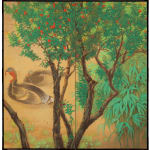Tomita Hankei
Turkeys under a Poinciana Tree, 1920s
Oversized two-panel folding screen; ink, mineral pigments, shell powder, gold and gold wash on silk
Size 79¼ x 77 in. (201 x 195.5 cm)
T-3361
Further images
Tomita Hankei was a student of the noted artists Tsuji Kakô (1870-1931) and Ikegami Shûho (1874-1944) and excelled in paintings of birds and flowers. All his entries into the national...
Tomita Hankei was a student of the noted artists Tsuji Kakô (1870-1931) and Ikegami Shûho (1874-1944) and excelled in paintings of birds and flowers. All his entries into the national exhibitions are in fact on this theme. The present screen is no exception and depicts a pair of turkeys, birds that had recently been imported and cultivated as an exotic bird. We know from the works of other artists that turkeys were viewed with great fascination by Taisho and early Showa era artists, and they appear repeatedly in the art of Nihonga painters from this time. According to a long tradition in Japanese paintings, birds were often imbued with symbolic meaning, and this was also the case with turkeys. They were also juxtaposed with native cranes in order present a symbolic contrast of Japan versus the Western world.
The artist has here cleverly highlighted the red throat of the male turkey (a key point of fascination) by drawing it in the same colors as the red and orange blooms of the tree in the center of the screen. The screen is in fact an exercise in the foreign and the exotic: the flamboyant red and orange flowers in the upper foreground are blooms of the Royal Poinciana Tree (Delonix regia), a plant endemic to Madagascar, that had become cultivated across Asia and in the West. The only native element in the painting is the group of native bamboo in the lower right corner of the screen, next to the seal of the artist. It is as if the artist indicates his own origin and viewpoint, experiencing the exotic from his own safe corner of Japan.
Hankei was born in Aichi Prefecture, near Nagoya, and although he spent much of his adult life in Tokyo, always thought of himself as an Aichi Prefecture artist. After his education in Tokyo, he joined a group of artists from his home province and founded the Aichi Society in 1918. This group of artists who were active in Tokyo became very influential in the growth of local artists by holding yearly exhibitions of their art in Nagoya, spreading in this way an awareness of trends in the capital city back to Aichi Prefecture.
Hankei was active in pre-war art organizations, such as the Nihon Bijutsuin (Japan Art Institute) and exhibited in several national exhibitions. He exhibited for example in the 10th annual Teiten exhibition in 1929, where he showed a well-received screen with depictions of chicken. In addition, he exhibited in the 14th Teiten exhibition in 1933, and in the prestigious Bunten exhibition no less than three times, in 1914, 1917, and 1918.
The artist has here cleverly highlighted the red throat of the male turkey (a key point of fascination) by drawing it in the same colors as the red and orange blooms of the tree in the center of the screen. The screen is in fact an exercise in the foreign and the exotic: the flamboyant red and orange flowers in the upper foreground are blooms of the Royal Poinciana Tree (Delonix regia), a plant endemic to Madagascar, that had become cultivated across Asia and in the West. The only native element in the painting is the group of native bamboo in the lower right corner of the screen, next to the seal of the artist. It is as if the artist indicates his own origin and viewpoint, experiencing the exotic from his own safe corner of Japan.
Hankei was born in Aichi Prefecture, near Nagoya, and although he spent much of his adult life in Tokyo, always thought of himself as an Aichi Prefecture artist. After his education in Tokyo, he joined a group of artists from his home province and founded the Aichi Society in 1918. This group of artists who were active in Tokyo became very influential in the growth of local artists by holding yearly exhibitions of their art in Nagoya, spreading in this way an awareness of trends in the capital city back to Aichi Prefecture.
Hankei was active in pre-war art organizations, such as the Nihon Bijutsuin (Japan Art Institute) and exhibited in several national exhibitions. He exhibited for example in the 10th annual Teiten exhibition in 1929, where he showed a well-received screen with depictions of chicken. In addition, he exhibited in the 14th Teiten exhibition in 1933, and in the prestigious Bunten exhibition no less than three times, in 1914, 1917, and 1918.
Literature
Selected bibliography:
Aichi Prefectural Museum of Art 愛知県立美術館, ed. Nijû-seiki Aichi no bijutsu 20世紀愛知の美術. Nagoya: Aichi Prefectural Museum of Art 愛知県立美術館, 1993.











